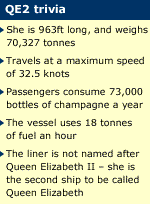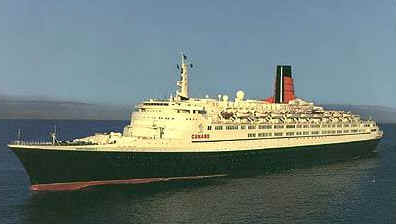Home > Ocean Liners > Queen Elizabeth 2 > QE2 News > QE2 News 1998 to 2001 > QE2 - 30 years of cruising
QE2 - 30 years of cruising
Taken without permission from the excellent BBC News website, Wednesday, April 14, 1999 - http://news.bbc.co.uk/1/hi/uk/319027.stm
Launched by the Queen from its shipyard on the Clyde in September 1967, the QE2 has become part of the nation's identity.
Launched by the Queen from its shipyard on the Clyde in September 1967, the QE2 has become part of the nation's identity.
 73,000 bottles of bubbly are drunk every year on the QE2
73,000 bottles of bubbly are drunk every year on the QE2
Its maiden voyage - from Southampton to New York - did not come for almost another two years. From that point on, the QE2 has come to represent the ultimate in luxury travel.
The liner was used as a troop carrier during the Falklands War of 1982, and was welcomed home by the Queen Mother.
And she is regarded, despite a number of revamp hiccups, as one of the last vestiges of the unhurried, luxuriant travel of a by-gone era - a perfect antidote to contemporary high-tech, globalised society.
Although the crowds which send the liner off on each transatlantic voyage have now dwindled to mere handfuls, there is still a brass band playing on Southampton dock every time she ups anchor.
And, although not quite as severe as the class divisions on the Titanic, the liner maintains its "cabin grades" system, which means that passengers eat in areas designated to the standard of their ticket.
Among those who have travelled on board are the Queen, the Duke of Edinburgh, the Prince of Wales, Diana, Princess of Wales, Prince Edward, the late King Hussein of Jordan and the Sultan of Brunei.
Although the QE2 docks in New York more than 20 times in one year, she never stops the night, requiring the crew to perform a huge "turnaround" operation.
The liner was used as a troop carrier during the Falklands War of 1982, and was welcomed home by the Queen Mother.
And she is regarded, despite a number of revamp hiccups, as one of the last vestiges of the unhurried, luxuriant travel of a by-gone era - a perfect antidote to contemporary high-tech, globalised society.
Although the crowds which send the liner off on each transatlantic voyage have now dwindled to mere handfuls, there is still a brass band playing on Southampton dock every time she ups anchor.
And, although not quite as severe as the class divisions on the Titanic, the liner maintains its "cabin grades" system, which means that passengers eat in areas designated to the standard of their ticket.
Among those who have travelled on board are the Queen, the Duke of Edinburgh, the Prince of Wales, Diana, Princess of Wales, Prince Edward, the late King Hussein of Jordan and the Sultan of Brunei.
Although the QE2 docks in New York more than 20 times in one year, she never stops the night, requiring the crew to perform a huge "turnaround" operation.

There was a time when this huge logistical manoeuvre would have taken 48 hours, but profit margins now require the ship to be kept almost perpetually in motion.
It stops only to take on approximately 2,000 tons of fuel and 1,000 tons of fresh water, exchange 2,000 pieces of baggage and to undergo lifeboat drill.
The liner's supplies cupboards have to be stocked up. One travel writer wrote that she regularly takes on something in the order of 575 pounds of coffee, 42,987 eggs, 485 pounds of mayonnaise, 2,405 pounds of butter, 9,020 feet of aluminum foil and 15,000 cocktail stirrers during one of these turnarounds.
She maintains this traditional route for about 100 days a year, sailing other itineraries the rest of the time.
It stops only to take on approximately 2,000 tons of fuel and 1,000 tons of fresh water, exchange 2,000 pieces of baggage and to undergo lifeboat drill.
The liner's supplies cupboards have to be stocked up. One travel writer wrote that she regularly takes on something in the order of 575 pounds of coffee, 42,987 eggs, 485 pounds of mayonnaise, 2,405 pounds of butter, 9,020 feet of aluminum foil and 15,000 cocktail stirrers during one of these turnarounds.
She maintains this traditional route for about 100 days a year, sailing other itineraries the rest of the time.

Even though the liner is loved by many for her timeless qualities, she has undergone several refits and modernisations.
In 1987, for example, she switched from a steam turbine engine to diesel-electric power. And a £19.5m refit has just been announced for November this year.
But it hasn't all been plain sailing. Low points in the liner's history have included being grounded, and a "cruise to Hell" where passengers complained about building work.
In 1996, when Cunard's parent company was bought out by the Norwegian conglomerate Kvaerner ASA, a multi-million pound upgrade of the liner was approved, to bring it in line with new Safety of Life at Sea codes. "This magnificent vessel, certainly the most famous ship afloat, will sail into the millennium with new vigour, displaying interiors that will express her stately grandeur in totally British terms," said Cunard president Larry Pimentel.
In 1987, for example, she switched from a steam turbine engine to diesel-electric power. And a £19.5m refit has just been announced for November this year.
But it hasn't all been plain sailing. Low points in the liner's history have included being grounded, and a "cruise to Hell" where passengers complained about building work.
In 1996, when Cunard's parent company was bought out by the Norwegian conglomerate Kvaerner ASA, a multi-million pound upgrade of the liner was approved, to bring it in line with new Safety of Life at Sea codes. "This magnificent vessel, certainly the most famous ship afloat, will sail into the millennium with new vigour, displaying interiors that will express her stately grandeur in totally British terms," said Cunard president Larry Pimentel.
